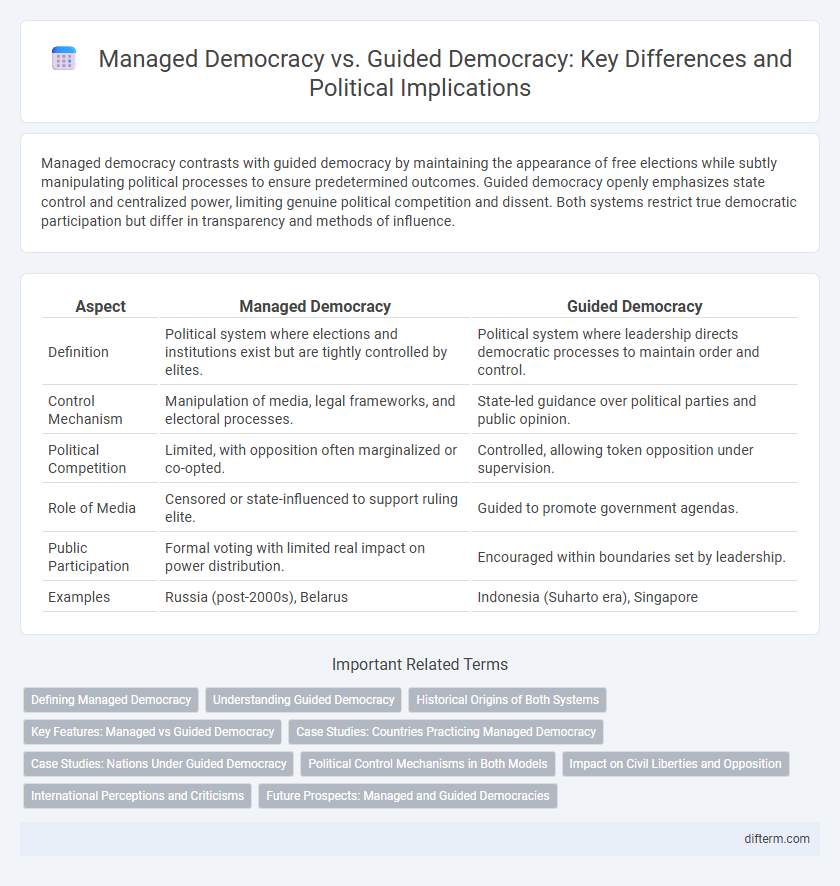Managed democracy contrasts with guided democracy by maintaining the appearance of free elections while subtly manipulating political processes to ensure predetermined outcomes. Guided democracy openly emphasizes state control and centralized power, limiting genuine political competition and dissent. Both systems restrict true democratic participation but differ in transparency and methods of influence.
Table of Comparison
| Aspect | Managed Democracy | Guided Democracy |
|---|---|---|
| Definition | Political system where elections and institutions exist but are tightly controlled by elites. | Political system where leadership directs democratic processes to maintain order and control. |
| Control Mechanism | Manipulation of media, legal frameworks, and electoral processes. | State-led guidance over political parties and public opinion. |
| Political Competition | Limited, with opposition often marginalized or co-opted. | Controlled, allowing token opposition under supervision. |
| Role of Media | Censored or state-influenced to support ruling elite. | Guided to promote government agendas. |
| Public Participation | Formal voting with limited real impact on power distribution. | Encouraged within boundaries set by leadership. |
| Examples | Russia (post-2000s), Belarus | Indonesia (Suharto era), Singapore |
Defining Managed Democracy
Managed democracy refers to a political system where electoral processes and civil liberties exist but are systematically controlled to ensure the dominance of a specific ruling party or elite. This model often features state influence over media, judiciary, and political opposition, limiting genuine democratic competition. Managed democracy contrasts with liberal democracy by prioritizing stability and regime continuity over pluralistic political participation.
Understanding Guided Democracy
Guided democracy refers to a political system where electoral processes and institutions appear democratic, but real power is concentrated in the hands of a ruling elite that directs political outcomes behind the scenes. Unlike managed democracy, which subtly shapes political competition through legal and administrative controls, guided democracy actively manipulates public opinion, controls the media, and limits genuine political pluralism to maintain regime stability. This system often employs informal networks and state resources to ensure that opposition forces remain weak and political dissent is marginalized.
Historical Origins of Both Systems
Managed democracy emerged in post-Soviet Russia during the early 2000s as a system designed to maintain the appearance of democratic processes while controlling political outcomes through centralized authority and media influence. Guided democracy, rooted in Indonesia's Sukarno era of the late 1950s and early 1960s, was characterized by a strong authoritarian regime that manipulated democratic institutions to consolidate power and suppress dissent. Both systems evolved as responses to political instability, blending elements of authoritarianism with nominal democratic structures to legitimize their rule domestically and internationally.
Key Features: Managed vs Guided Democracy
Managed democracy features controlled political competition, where elections occur but outcomes are often predetermined by elite interests, limiting genuine pluralism. Guided democracy emphasizes centralized authority, with significant influence by a dominant leader or party shaping political processes, often curbing opposition and independent institutions. Both models restrict democratic freedoms but differ in their mechanisms of political control and citizen participation.
Case Studies: Countries Practicing Managed Democracy
Russia exemplifies managed democracy through controlled elections and centralized media to maintain political stability while projecting a democratic facade. Turkey employs managed democracy by limiting opposition influence and manipulating judicial systems to consolidate power within the ruling party. In Hungary, the government uses legal reforms and media control to guide electoral outcomes, reflecting key characteristics of managed democracy in practice.
Case Studies: Nations Under Guided Democracy
Nations under guided democracy, such as Indonesia during Sukarno's era and Russia in the early 2000s, demonstrate political systems where strong central authorities limit opposition to maintain control while preserving the facade of democratic institutions. These case studies highlight how managed democratic frameworks manipulate electoral processes, media, and civil society to sustain regime legitimacy without full political pluralism. Analysis reveals patterns of controlled political competition and restricted freedoms, distinguishing guided democracy from more open democratic models.
Political Control Mechanisms in Both Models
Managed democracy employs controlled electoral processes, media influence, and centralized party systems to maintain political stability while allowing limited public participation. Guided democracy, often characterized by authoritative leadership, uses direct state intervention, restricted political competition, and regulatory oversight to shape policy outcomes and suppress dissent. Both models rely on institutional mechanisms such as electoral manipulation, media censorship, and legal constraints to ensure regime continuity and control over political narratives.
Impact on Civil Liberties and Opposition
Managed democracy often curtails civil liberties by implementing controlled political participation and limiting free speech, thereby weakening genuine opposition. Guided democracy allows some degree of political pluralism but channels dissent through state-approved mechanisms, reducing the effectiveness of opposition movements. Both systems prioritize regime stability over full democratic freedoms, significantly impacting citizens' rights to freely express and organize.
International Perceptions and Criticisms
Managed democracy often faces international criticism for undermining genuine political pluralism and restricting free electoral processes, fostering skepticism about its democratic authenticity. Guided democracy is perceived by global observers as a mechanism where state elites manipulate political outcomes, raising concerns over authoritarian tendencies and diminished civil liberties. Both systems attract scrutiny for prioritizing regime stability over transparent governance, prompting debates on their impact on global democratic norms.
Future Prospects: Managed and Guided Democracies
Managed democracy centralizes control over political processes while maintaining the facade of electoral competition, potentially limiting genuine pluralism and citizen participation. Guided democracy allows more overt influence by elite or authoritarian actors to steer decision-making, often justifying constraints on political freedoms as necessary for stability. Future prospects of both models hinge on balancing control with increasing demands for transparency, accountability, and democratic reforms to address evolving societal and global challenges.
managed democracy vs guided democracy Infographic

 difterm.com
difterm.com